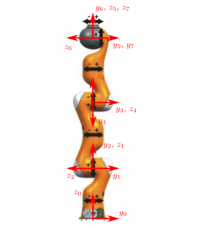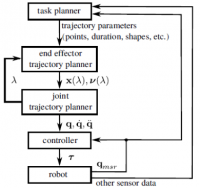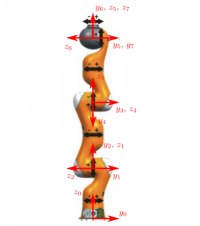Start » Badania » Projekty badawcze »
Optimal trajectory planning for redundant manipulators
The Predictive Quadratic Programming Inverse Kinematics with Scaling (PQPIK-S) designed in this project solves this quandary by combining the inverse kinematics (IK) problem with trajectory scaling and solving them simultaneously.
Optimal trajectory planning for redundant manipulators
A kinematically redundant structure increases the dexterity of the robotic manipulator and offers an ability to avoid obstacles and handle singularities. Therefore, redundant robots are well-suited for work in human-centered, cluttered environments. However, planning of the joint trajectory that satisfies the desired end effector trajectory and does not exceed the capabilities of the robot joints is not a trivial task.
The Predictive Quadratic Programming Inverse Kinematics with Scaling (PQPIK-S) designed in this project solves this quandary by combining the inverse kinematics (IK) problem with trajectory scaling and solving them simultaneously.
The QP problem is formulated in such a way that it utilizes the prediction of the future joint states of the manipulator, allowing to begin the trajectory scaling early, if needed. Outside the prediction horizon, the desired end effector trajectory does not to be known, allowing for replanning when working in dynamic environments. The obtained joint trajectory is optimal: inside the prediction horizon, it satisfies the end effector trajectory (the main task), fulfills in the best way the secondary tasks (such as joint velocity minimization or obstacle avoidance), and maintains the least possible scaling, all with regards to the joint constraints.
|
|
|
The PQPIK-S plays the role of the joint trajectory planner block. It was implemented in C++ with the use of the Eigen library for linear algebra and qpOASES containing the active-set solver for the QP problem.
Comprehensive simulation studies performed during this project prove the PQPIK-S’s advantages compared to the classic IK methods. The most important feature of the PQPIK-S is the ability to satisfy the joint constraints, slowing down the end effector motion only when needed.
Moreover, the PQPIK-S computations are done within a 10-millisecond cycle, allowing for a real-time operation. The experiments performed on KUKA LWR 4+ redundant robot present in the Division’s Robotics Laboratory prove the feasibility of the PQPIK-S-generated joint trajectories. The experiments were performed with the use of the Fast Research Interface – KUKA’s interface for the communication between the user’s PC and KUKA Robot Controller (KRC).






